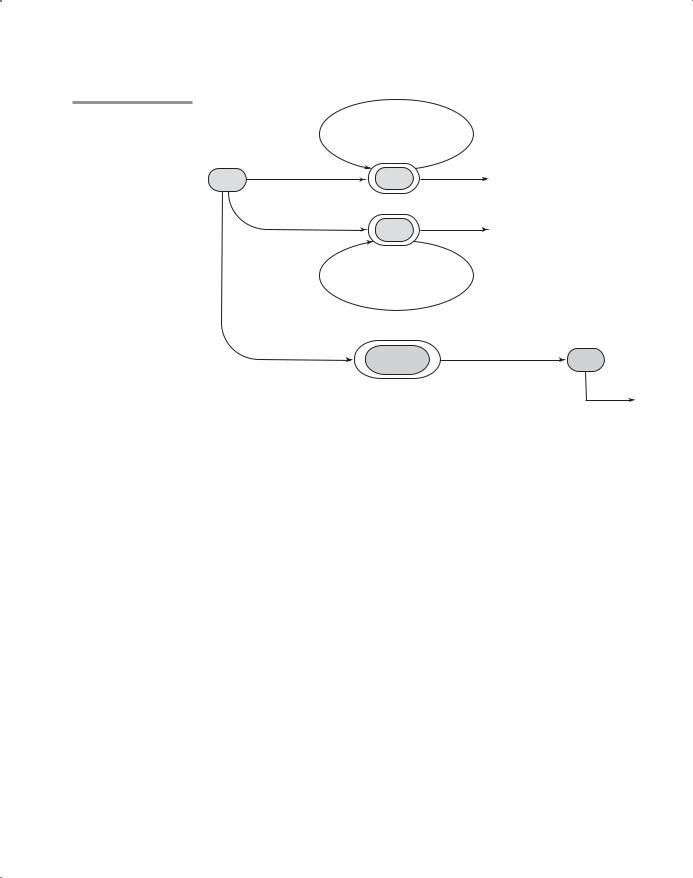
- •New to the Tenth Edition
- •Preface
- •Acknowledgments
- •About the Author
- •Contents
- •1.1 Reasons for Studying Concepts of Programming Languages
- •1.2 Programming Domains
- •1.3 Language Evaluation Criteria
- •1.4 Influences on Language Design
- •1.5 Language Categories
- •1.6 Language Design Trade-Offs
- •1.7 Implementation Methods
- •1.8 Programming Environments
- •Summary
- •Problem Set
- •2.1 Zuse’s Plankalkül
- •2.2 Pseudocodes
- •2.3 The IBM 704 and Fortran
- •2.4 Functional Programming: LISP
- •2.5 The First Step Toward Sophistication: ALGOL 60
- •2.6 Computerizing Business Records: COBOL
- •2.7 The Beginnings of Timesharing: BASIC
- •2.8 Everything for Everybody: PL/I
- •2.9 Two Early Dynamic Languages: APL and SNOBOL
- •2.10 The Beginnings of Data Abstraction: SIMULA 67
- •2.11 Orthogonal Design: ALGOL 68
- •2.12 Some Early Descendants of the ALGOLs
- •2.13 Programming Based on Logic: Prolog
- •2.14 History’s Largest Design Effort: Ada
- •2.15 Object-Oriented Programming: Smalltalk
- •2.16 Combining Imperative and Object-Oriented Features: C++
- •2.17 An Imperative-Based Object-Oriented Language: Java
- •2.18 Scripting Languages
- •2.19 The Flagship .NET Language: C#
- •2.20 Markup/Programming Hybrid Languages
- •Review Questions
- •Problem Set
- •Programming Exercises
- •3.1 Introduction
- •3.2 The General Problem of Describing Syntax
- •3.3 Formal Methods of Describing Syntax
- •3.4 Attribute Grammars
- •3.5 Describing the Meanings of Programs: Dynamic Semantics
- •Bibliographic Notes
- •Problem Set
- •4.1 Introduction
- •4.2 Lexical Analysis
- •4.3 The Parsing Problem
- •4.4 Recursive-Descent Parsing
- •4.5 Bottom-Up Parsing
- •Summary
- •Review Questions
- •Programming Exercises
- •5.1 Introduction
- •5.2 Names
- •5.3 Variables
- •5.4 The Concept of Binding
- •5.5 Scope
- •5.6 Scope and Lifetime
- •5.7 Referencing Environments
- •5.8 Named Constants
- •Review Questions
- •6.1 Introduction
- •6.2 Primitive Data Types
- •6.3 Character String Types
- •6.4 User-Defined Ordinal Types
- •6.5 Array Types
- •6.6 Associative Arrays
- •6.7 Record Types
- •6.8 Tuple Types
- •6.9 List Types
- •6.10 Union Types
- •6.11 Pointer and Reference Types
- •6.12 Type Checking
- •6.13 Strong Typing
- •6.14 Type Equivalence
- •6.15 Theory and Data Types
- •Bibliographic Notes
- •Programming Exercises
- •7.1 Introduction
- •7.2 Arithmetic Expressions
- •7.3 Overloaded Operators
- •7.4 Type Conversions
- •7.5 Relational and Boolean Expressions
- •7.6 Short-Circuit Evaluation
- •7.7 Assignment Statements
- •7.8 Mixed-Mode Assignment
- •Summary
- •Problem Set
- •Programming Exercises
- •8.1 Introduction
- •8.2 Selection Statements
- •8.3 Iterative Statements
- •8.4 Unconditional Branching
- •8.5 Guarded Commands
- •8.6 Conclusions
- •Programming Exercises
- •9.1 Introduction
- •9.2 Fundamentals of Subprograms
- •9.3 Design Issues for Subprograms
- •9.4 Local Referencing Environments
- •9.5 Parameter-Passing Methods
- •9.6 Parameters That Are Subprograms
- •9.7 Calling Subprograms Indirectly
- •9.8 Overloaded Subprograms
- •9.9 Generic Subprograms
- •9.10 Design Issues for Functions
- •9.11 User-Defined Overloaded Operators
- •9.12 Closures
- •9.13 Coroutines
- •Summary
- •Programming Exercises
- •10.1 The General Semantics of Calls and Returns
- •10.2 Implementing “Simple” Subprograms
- •10.3 Implementing Subprograms with Stack-Dynamic Local Variables
- •10.4 Nested Subprograms
- •10.5 Blocks
- •10.6 Implementing Dynamic Scoping
- •Problem Set
- •Programming Exercises
- •11.1 The Concept of Abstraction
- •11.2 Introduction to Data Abstraction
- •11.3 Design Issues for Abstract Data Types
- •11.4 Language Examples
- •11.5 Parameterized Abstract Data Types
- •11.6 Encapsulation Constructs
- •11.7 Naming Encapsulations
- •Summary
- •Review Questions
- •Programming Exercises
- •12.1 Introduction
- •12.2 Object-Oriented Programming
- •12.3 Design Issues for Object-Oriented Languages
- •12.4 Support for Object-Oriented Programming in Smalltalk
- •12.5 Support for Object-Oriented Programming in C++
- •12.6 Support for Object-Oriented Programming in Objective-C
- •12.7 Support for Object-Oriented Programming in Java
- •12.8 Support for Object-Oriented Programming in C#
- •12.9 Support for Object-Oriented Programming in Ada 95
- •12.10 Support for Object-Oriented Programming in Ruby
- •12.11 Implementation of Object-Oriented Constructs
- •Summary
- •Programming Exercises
- •13.1 Introduction
- •13.2 Introduction to Subprogram-Level Concurrency
- •13.3 Semaphores
- •13.4 Monitors
- •13.5 Message Passing
- •13.6 Ada Support for Concurrency
- •13.7 Java Threads
- •13.8 C# Threads
- •13.9 Concurrency in Functional Languages
- •13.10 Statement-Level Concurrency
- •Summary
- •Review Questions
- •Problem Set
- •14.1 Introduction to Exception Handling
- •14.2 Exception Handling in Ada
- •14.3 Exception Handling in C++
- •14.4 Exception Handling in Java
- •14.5 Introduction to Event Handling
- •14.6 Event Handling with Java
- •14.7 Event Handling in C#
- •Review Questions
- •Problem Set
- •15.1 Introduction
- •15.2 Mathematical Functions
- •15.3 Fundamentals of Functional Programming Languages
- •15.4 The First Functional Programming Language: LISP
- •15.5 An Introduction to Scheme
- •15.6 Common LISP
- •15.8 Haskell
- •15.10 Support for Functional Programming in Primarily Imperative Languages
- •15.11 A Comparison of Functional and Imperative Languages
- •Review Questions
- •Problem Set
- •16.1 Introduction
- •16.2 A Brief Introduction to Predicate Calculus
- •16.3 Predicate Calculus and Proving Theorems
- •16.4 An Overview of Logic Programming
- •16.5 The Origins of Prolog
- •16.6 The Basic Elements of Prolog
- •16.7 Deficiencies of Prolog
- •16.8 Applications of Logic Programming
- •Review Questions
- •Programming Exercises
- •Bibliography
- •Index

168 |
Chapter 4 Lexical and Syntax Analysis |
Aserious investigation of compiler design requires at least a semester of intensive study, including the design and implementation of a compiler for a small but realistic programming language. The first part of such a course is
devoted to lexical and syntax analyses. The syntax analyzer is the heart of a compiler, because several other important components, including the semantic analyzer and the intermediate code generator, are driven by the actions of the syntax analyzer.
Some readers may wonder why a chapter on any part of a compiler would be included in a book on programming languages. There are at least two reasons to include a discussion of lexical and syntax analyses in this book: First, syntax analyzers are based directly on the grammars discussed in Chapter 3, so it is natural to discuss them as an application of grammars. Second, lexical and syntax analyzers are needed in numerous situations outside compiler design. Many applications, among them program listing formatters, programs that compute the complexity of programs, and programs that must analyze and react to the contents of a configuration file, all need to do lexical and syntax analyses. Therefore, lexical and syntax analyses are important topics for software developers, even if they never need to write a compiler. Furthermore, some computer science programs no longer require students to take a compiler design course, which leaves students with no instruction in lexical or syntax analysis. In those cases, this chapter can be covered in the programming language course. In degree programs that require a compiler design course, this chapter can be skipped.
This chapter begins with an introduction to lexical analysis, along with a simple example. Next, the general parsing problem is discussed, including the two primary approaches to parsing and the complexity of parsing. Then, we introduce the recursivedescent implementation technique for top-down parsers, including examples of parts of a recursive-descent parser and a trace of a parse using one. The last section discusses bottom-up parsing and the LR parsing algorithm. This section includes an example of a small LR parsing table and the parse of a string using the LR parsing process.
4.1 Introduction
Three different approaches to implementing programming languages are introduced in Chapter 1: compilation, pure interpretation, and hybrid implementation. The compilation approach uses a program called a compiler, which translates programs written in a high-level programming language into machine code. Compilation is typically used to implement programming languages that are used for large applications, often written in languages such as C++ and COBOL. Pure interpretation systems perform no translation; rather, programs are interpreted in their original form by a software interpreter. Pure interpretation is usually used for smaller systems in which execution efficiency is not critical, such as scripts embedded in HTML documents, written in languages such as JavaScript. Hybrid implementation systems translate programs written in high-level languages into intermediate forms, which are interpreted. These systems are now more widely used than ever, thanks in large part to the popularity of scripting languages. Traditionally, hybrid systems have resulted in much slower program execution than compiler systems. However, in recent

4.2 Lexical Analysis |
169 |
years the use of Just-in-Time ( JIT) compilers has become widespread, particularly for Java programs and programs written for the Microsoft .NET system.
AJIT compiler, which translates intermediate code to machine code, is used on methods at the time they are first called. In effect, a JIT compiler transforms a hybrid system to a delayed compiler system.
All three of the implementation approaches just discussed use both lexical and syntax analyzers.
Syntax analyzers, or parsers, are nearly always based on a formal description of the syntax of programs. The most commonly used syntax-description formalism is context-free grammars, or BNF, which is introduced in Chapter 3. Using BNF, as opposed to using some informal syntax description, has at least three compelling advantages. First, BNF descriptions of the syntax of programs are clear and concise, both for humans and for software systems that use them. Second, the BNF description can be used as the direct basis for the syntax analyzer. Third, implementations based on BNF are relatively easy to maintain because of their modularity.
Nearly all compilers separate the task of analyzing syntax into two distinct parts, named lexical analysis and syntax analysis, although this terminology is confusing. The lexical analyzer deals with small-scale language constructs, such as names and numeric literals. The syntax analyzer deals with the large-scale constructs, such as expressions, statements, and program units. Section 4.2 introduces lexical analyzers. Sections 4.3, 4.4, and 4.5 discuss syntax analyzers.
There are three reasons why lexical analysis is separated from syntax analysis:
1.Simplicity—Techniques for lexical analysis are less complex than those required for syntax analysis, so the lexical-analysis process can be simpler if it is separate. Also, removing the low-level details of lexical analysis from the syntax analyzer makes the syntax analyzer both smaller and less complex.
2.Efficiency—Although it pays to optimize the lexical analyzer, because lexical analysis requires a significant portion of total compilation time, it is not fruitful to optimize the syntax analyzer. Separation facilitates this selective optimization.
3.Portability—Because the lexical analyzer reads input program files and often includes buffering of that input, it is somewhat platform dependent. However, the syntax analyzer can be platform independent. It is always good to isolate machine-dependent parts of any software system.
4.2Lexical Analysis
Alexical analyzer is essentially a pattern matcher. A pattern matcher attempts to find a substring of a given string of characters that matches a given character pattern. Pattern matching is a traditional part of computing. One of the earliest uses

170 |
Chapter 4 Lexical and Syntax Analysis |
of pattern matching was with text editors, such as the ed line editor, which was introduced in an early version of UNIX. Since then, pattern matching has found its way into some programming languages—for example, Perl and JavaScript. It is also available through the standard class libraries of Java, C++, and C#.
A lexical analyzer serves as the front end of a syntax analyzer. Technically, lexical analysis is a part of syntax analysis. A lexical analyzer performs syntax analysis at the lowest level of program structure. An input program appears to a compiler as a single string of characters. The lexical analyzer collects characters into logical groupings and assigns internal codes to the groupings according to their structure. In Chapter 3, these logical groupings are named lexemes, and the internal codes for categories of these groupings are named tokens. Lexemes are recognized by matching the input character string against character string patterns. Although tokens are usually represented as integer values, for the sake of readability of lexical and syntax analyzers, they are often referenced through named constants.
Consider the following example of an assignment statement:
result = oldsum – value / 100;
Following are the tokens and lexemes of this statement:
Token |
Lexeme |
IDENT |
result |
ASSIGN_OP |
= |
IDENT |
oldsum |
SUB_OP |
- |
IDENT |
value |
DIV_OP |
/ |
INT_LIT |
100 |
SEMICOLON |
; |
Lexical analyzers extract lexemes from a given input string and produce the corresponding tokens. In the early days of compilers, lexical analyzers often processed an entire source program file and produced a file of tokens and lexemes. Now, however, most lexical analyzers are subprograms that locate the next lexeme in the input, determine its associated token code, and return them to the caller, which is the syntax analyzer. So, each call to the lexical analyzer returns a single lexeme and its token. The only view of the input program seen by the syntax analyzer is the output of the lexical analyzer, one token at a time.
The lexical-analysis process includes skipping comments and white space outside lexemes, as they are not relevant to the meaning of the program. Also, the lexical analyzer inserts lexemes for user-defined names into the symbol table, which is used by later phases of the compiler. Finally, lexical analyzers detect syntactic errors in tokens, such as ill-formed floating-point literals, and report such errors to the user.

4.2 Lexical Analysis |
171 |
There are three approaches to building a lexical analyzer:
1.Write a formal description of the token patterns of the language using a descriptive language related to regular expressions.1 These descriptions are used as input to a software tool that automatically generates a lexical analyzer. There are many such tools available for this. The oldest of these, named lex, is commonly included as part of UNIX systems.
2.Design a state transition diagram that describes the token patterns of the language and write a program that implements the diagram.
3.Design a state transition diagram that describes the token patterns of the language and hand-construct a table-driven implementation of the state diagram.
A state transition diagram, or just state diagram, is a directed graph. The nodes of a state diagram are labeled with state names. The arcs are labeled with the input characters that cause the transitions among the states. An arc may also include actions the lexical analyzer must perform when the transition is taken.
State diagrams of the form used for lexical analyzers are representations of a class of mathematical machines called finite automata. Finite automata can be designed to recognize members of a class of languages called regular languages. Regular grammars are generative devices for regular languages. The tokens of a programming language are a regular language, and a lexical analyzer is a finite automaton.
We now illustrate lexical-analyzer construction with a state diagram and the code that implements it. The state diagram could simply include states and transitions for each and every token pattern. However, that approach results in a very large and complex diagram, because every node in the state diagram would need a transition for every character in the character set of the language being analyzed. We therefore consider ways to simplify it.
Suppose we need a lexical analyzer that recognizes only arithmetic expressions, including variable names and integer literals as operands. Assume that the variable names consist of strings of uppercase letters, lowercase letters, and digits but must begin with a letter. Names have no length limitation. The first thing to observe is that there are 52 different characters (any uppercase or lowercase letter) that can begin a name, which would require 52 transitions from the transition diagram’s initial state. However, a lexical analyzer is interested only in determining that it is a name and is not concerned with which specific name it happens to be. Therefore, we define a character class named LETTER for all 52 letters and use a single transition on the first letter of any name.
Another opportunity for simplifying the transition diagram is with the integer literal tokens. There are 10 different characters that could begin an integer literal lexeme. This would require 10 transitions from the start state of the state diagram. Because specific digits are not a concern of the lexical analyzer, we can build a much more compact state diagram if we define a character
1.These regular expressions are the basis for the pattern-matching facilities now part of many programming languages, either directly or through a class library.

172 |
Chapter 4 Lexical and Syntax Analysis |
class named DIGIT for digits and use a single transition on any character in this character class to a state that collects integer literals.
Because our names can include digits, the transition from the node following the first character of a name can use a single transition on LETTER or DIGIT to continue collecting the characters of a name.
Next, we define some utility subprograms for the common tasks inside the lexical analyzer. First, we need a subprogram, which we can name getChar, that has several duties. When called, getChar gets the next character of input from the input program and puts it in the global variable nextChar. getChar must also determine the character class of the input character and put it in the global variable charClass. The lexeme being built by the lexical analyzer, which could be implemented as a character string or an array, will be named lexeme.
We implement the process of putting the character in nextChar into the string array lexeme in a subprogram named addChar. This subprogram must be explicitly called because programs include some characters that need not be put in lexeme, for example the white-space characters between lexemes. In a more realistic lexical analyzer, comments also would not be placed in lexeme.
When the lexical analyzer is called, it is convenient if the next character of input is the first character of the next lexeme. Because of this, a function named getNonBlank is used to skip white space every time the analyzer is called.
Finally, a subprogram named lookup is needed to compute the token code for the single-character tokens. In our example, these are parentheses and the arithmetic operators. Token codes are numbers arbitrarily assigned to tokens by the compiler writer.
The state diagram in Figure 4.1 describes the patterns for our tokens. It includes the actions required on each transition of the state diagram.
The following is a C implementation of a lexical analyzer specified in the state diagram of Figure 4.1, including a main driver function for testing purposes:
/* front.c - a lexical analyzer system for simple arithmetic expressions */
#include <stdio.h> #include <ctype.h>
/* Global declarations */ /* Variables */
int charClass; char lexeme [100]; char nextChar; int lexLen;
int token; int nextToken;
FILE *in_fp, *fopen();

Figure 4.1
A state diagram to recognize names, parentheses, and arithmetic operators
|
4.2 |
Lexical Analysis |
173 |
|
Letter/Digit |
|
|
|
addChar; getChar |
|
|
|
Letter |
return lookup (lexeme) |
|
Start |
id |
|
|
|
addChar; getChar |
|
|
|
Digit |
return Int_Lit |
|
|
int |
|
|
|
addChar; getChar |
|
|
Digit
addChar; getChar
t←lookup (nextChar)
unknown |
getChar |
Done |
|
|
return t
/* Function declarations */ void addChar();
void getChar(); void getNonBlank(); int lex();
/* Character classes */ #define LETTER 0 #define DIGIT 1
#define UNKNOWN 99
/* Token codes */ #define INT_LIT 10 #define IDENT 11 #define ASSIGN_OP 20 #define ADD_OP 21 #define SUB_OP 22 #define MULT_OP 23 #define DIV_OP 24 #define LEFT_PAREN 25 #define RIGHT_PAREN 26

174 |
Chapter 4 Lexical and Syntax Analysis |
/******************************************************/ /* main driver */
main() {
/* Open the input data file and process its contents */ if ((in_fp = fopen("front.in", "r")) == NULL)
printf("ERROR - cannot open front.in \n"); else {
getChar();
do {
lex();
} while (nextToken != EOF);
}
}
/*****************************************************/ /* lookup - a function to lookup operators and parentheses
and return the token */ int lookup(char ch) {
switch (ch) { case '(':
addChar();
nextToken = LEFT_PAREN; break;
case ')':
addChar();
nextToken = RIGHT_PAREN; break;
case '+':
addChar(); nextToken = ADD_OP; break;
case '-': addChar();
nextToken = SUB_OP; break;
case '*':
addChar();
nextToken = MULT_OP; break;

4.2 Lexical Analysis |
175 |
case '/':
addChar(); nextToken = DIV_OP; break;
default: addChar(); nextToken = EOF; break;
}
return nextToken;
}
/*****************************************************/ /* addChar - a function to add nextChar to lexeme */ void addChar() {
if (lexLen <= 98) { lexeme[lexLen++] = nextChar; lexeme[lexLen] = 0;
}
else
printf("Error - lexeme is too long \n");
}
/*****************************************************/ /* getChar - a function to get the next character of
input and determine its character class */ void getChar() {
if ((nextChar = getc(in_fp)) != EOF) { if (isalpha(nextChar))
charClass = LETTER;
else if (isdigit(nextChar)) charClass = DIGIT;
else charClass = UNKNOWN;
}
else
charClass = EOF;
}
/*****************************************************/ /* getNonBlank - a function to call getChar until it
returns a non-whitespace character */ void getNonBlank() {
while (isspace(nextChar)) getChar();
}

176 |
Chapter 4 Lexical and Syntax Analysis |
/
*****************************************************/
/* lex - a simple lexical analyzer for arithmetic expressions */
int lex() { lexLen = 0; getNonBlank();
switch (charClass) {
/* Parse identifiers */ case LETTER:
addChar();
getChar();
while (charClass == LETTER || charClass == DIGIT) { addChar();
getChar();
}
nextToken = IDENT; break;
/* Parse integer literals */ case DIGIT:
addChar();
getChar();
while (charClass == DIGIT) { addChar();
getChar();
}
nextToken = INT_LIT; break;
/* Parentheses and operators */ case UNKNOWN:
lookup(nextChar);
getChar(); break;
/* EOF */
case EOF:
nextToken = EOF; lexeme[0] = 'E'; lexeme[1] = 'O'; lexeme[2] = 'F'; lexeme[3] = 0; break;
} /* End of switch */
